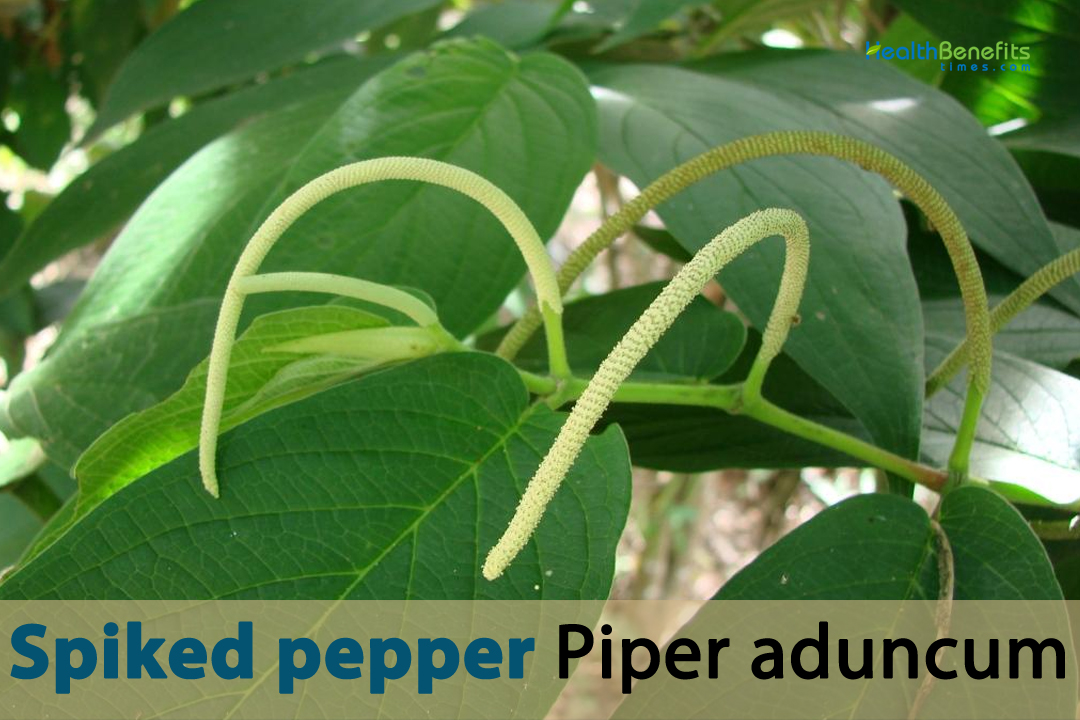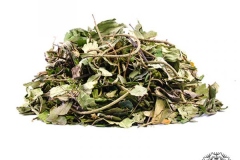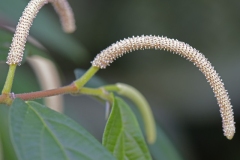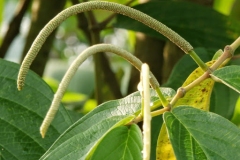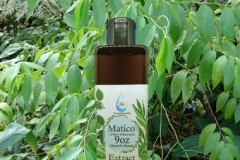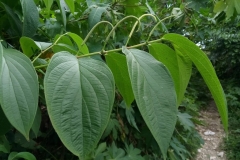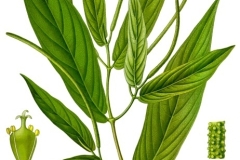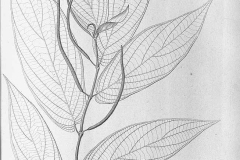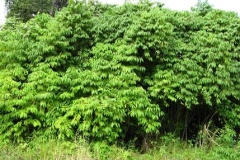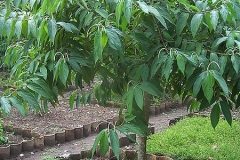The genus “Piper” is frequently applied to members of the Piperaceae family, which comprises an assortment of species commonly referred to as peppers. “Piper” is an appellation derived from the Latin verb “pipare,” signifying the act of peppering or the act of sprinkling with pepper. A considerable number of species within the Piper genus generate compounds that resemble pepper or spice. “Aduncum” is a specific epithet derived from the Latin for “hooked” or “bent.” It most probably pertains to the unique morphology of the foliage or an additional attribute of the botanical specimen. Similar to numerous other members of its family, this tree emits a distinct peppery aroma. The fruits are employed in the preparation of cocoa and as a condiment. On occasion, it is employed in place of long pepper.
Spiked Pepper Facts
| Spiked pepper Quick Facts | |
|---|---|
| Name: | Spiked pepper |
| Scientific Name: | Piper aduncum |
| Origin | Southern Mexico, Central America, the Caribbean and tropical South America |
| Colors | Initially green may turn red or black as they ripen |
| Shapes | Typically small and spherical, resembling tiny berries |
| Taste | Peppery, spicy, and pungent |
| Health benefits | Anti-Inflammatory Properties, Antioxidant Activity, Digestive Health, Pain Relief, Antimicrobial Effects, Respiratory Support, Insect Repellent |
| Name | Spiked pepper |
|---|---|
| Scientific Name | Piper aduncum |
| Native | Southern Mexico, Central America (i.e. Belize, Costa Rica, El Salvador, Guatemala, Honduras, Nicaragua and Panama), the Caribbean and tropical South America (i.e. French Guiana, Guyana, Surinam, Venezuela, Brazil, Bolivia, Colombia, Ecuador, Peru and parts of Amazon Rainforest) |
| Common Names | Anisillo, bamboo piper, cow’s foot, false kava, false matico, higuillo, jointwood, matico, piper, spiked pepperbush, spiked pepperbush, matico pepper, spiked pepper, stilt root piper |
| Name in Other Languages | Arabic: Matîkû, falafl diq alwaraq (فلفل ضيق الورق) Brazil: Aperta-João, aperta-ruao, jaborandi-do-mato, jaborandi-falso, pimenta-do-fruto-ganchoso Chinese: Xia ye hu jiao, Shù hújiāo (树胡椒) Cuba: Platanillo de Cuba English: Matico pepper, Spiked pepper, False kava, higuillo de hoja menuda, bamboo piper, matico Fijian: Honolulu yaqon, yanggona ni Onolulu, yaqona ni Onolulu French: Herbe du soldat, Matico German: Maticoblätter, Matico-Pfeffer, Soldatenkraut, Pfefferstrauch, Haken, Hakenpfefferstrauch Haitian: Bwa majò Italian: Erba di soldato Mexico: Cordoncillo blanco Persian: پیپر ادانکوم Portuguese: Pimenta longa, ti nixpu Kaxinawá, pimenta-de-macaco, aperta-ruão Spanish: Cordoncillo, Cordoncillo negro, Higuillo de hoja menuda, Hoja santa, Matico, higuillo, higuillo oloroso, platanillo de Cuba, cordoncillo blanco Turkish: Matiko |
| Plant Growth Habit | Tropical, evergreen shrub or small tree |
| Growing Climates | Disturbed rainforest areas, rainforest margins, riverbanks, thickets, open or disturbed areas, roadsides, forest edges, along streams, agricultural fields, pastures, and abandoned areas |
| Soil | Prefers well-draining, fertile, and slightly acidic to neutral soils. It can grow in a variety of soil types, including sandy loam, clay loam, and humus-rich soils. Good soil drainage is essential to prevent waterlogged roots |
| Plant Size | 3 to 6 meters (approximately 10 to 20 feet) tall, although it can sometimes grow even taller under optimal conditions |
| Stem | Erect and slender |
| Bark | Often coarse and may be faintly fissured or scaly |
| Leaf | Green colored leaf with smooth, serrated (toothed), or lobed margin |
| Flower | Small not showy. They typically have greenish-white or cream-colored petals and grow on spike-like inflorescences |
| Fruit Shape & Size | Typically small and spherical, resembling tiny berries |
| Fruit Color | Green when immature and may turn red or black as they ripen |
| Fruit Weight | Between 4 to 5 millimeters (approximately 0.16 to 0.20 inches) in diameter when fully mature |
| Seed | Small brown or dark in color |
| Flavor/Aroma | Peppery, spicy, and pungent |
| Taste | Peppery, spicy, and pungent |
| Plant Parts Used | Leaves, stem, fruits |
| Propagation | By seeds, stem cuttings and Division |
| Lifespan | Few years |
| Available Forms |
|
| Health benefits |
|
Plant Description
Spiked pepper is a tropical, evergreen shrub or small tree with a spreading crown. The tree can normally grows about 3 to 6 meters (approximately 10 to 20 feet) tall, although it can sometimes grow even taller under optimal conditions. The bole is around 7 cm in diameter, often with prop-roots and often branching at or near the base. The plant is found growing in disturbed rainforest areas, rainforest margins, riverbanks, thickets, open or disturbed areas, road sides, along streams, agricultural fields, pastures and abandoned areas. The plant prefers well-draining, fertile, and slightly acidic to neutral soils. It can grow in a variety of soil types, including sandy loam, clay loam, and humus-rich soils.
A widely utilized herbal remedy, the plant is frequently procured from natural sources and is distributed within the local community. It was utilized in Peru to staunch hemorrhages and treat ulceration, and in Europe to treat conditions affecting the urinary tract and genital organs, including those for which cubeb was frequently prescribed. The plant is also ornamental and is occasionally cultivated to provide soil cover. Certain nations classify it as an invasive vegetation. Although it is infamous for drying out the soil in areas of New Guinea where it is invasive, locals utilize the wood of this plant for a variety of purposes, including as fuel and fence posts.
Roots
The primary root, which emerges from the embryo during germination, is the origin of roots. Secondary roots emerge from the primary root as the plant develops; these roots aid in soil anchoring and nutrient absorption. Root hairs are minuscule, hair-like structures located at the apex of the secondary roots. Their function is to augment the overall surface area of the roots. A root crown surrounds the tip of the root system, providing protection for the vulnerable growing tip as it penetrates the soil and facilitating the detection of soil environmental changes.
Stem
Typically, the primary stem is erect and slender. As the central axis from which leaves, branches, and inflorescences (flower clusters) develop, it arises from the base of the plant. Nodes are the anatomical locations along the stem that give rise to leaves, branches, and blossoms. Small leaf-like structures, referred to as stipules, are commonly observed at each node. These structures exhibit substantial variation in both size and shape. The intervals between two consecutive nodes—the locations where leaves or branches affix to the stem—are referred to as internodes. Contingent on the plant’s growth stage and environmental conditions, their length may differ.
Bark
Typically, bark exhibits a brown or grayish-brown hue. Its texture is frequently coarse and may be faintly fissured or scaly. Although the bark’s thickness can differ, it is generally not excessively thick. Its distinctive aroma and flavor may be attributed to the presence of essential oils and other aromatic compounds in its bark, which are renowned for their aromatic qualities. Traditional medicine and certain indigenous civilizations employ the bark for a multitude of medicinal intentions. Further research is required to validate the potential benefits of this substance as an anti-inflammatory, antiseptic, or wound healer.
Leaves
The leaf blade consists of the leaf’s expanded and compressed portion. It is the primary location for photosynthesis and can differ in size and shape; it is typically green in color. The margins may be smooth, serrated (toothed), or lobed. Veins are vascular tissues that aid in the distribution of metabolic and growth resources. The central vein that travels longitudinally along the length of the leaf blade and aids in the transport of nutrients and fluids to and from the leaf is known as the midrib. Their petiole enables them to effectively capture sunlight and sway in the wind.
Flower
Spiked pepper commonly generates inflorescences, which are dense, cylindrical shafts containing its flowers. Particular flowers are typically quite diminutive and devoid of ostentatious petals or splashy hues. Their typical coloration ranges from green to yellow. Modified leaves known as bracts are typically found at the base of each cluster of flowers within the spike. The bracts potentially function to shield or uphold the blooms. The calyx of a flower is made up of sepals. Typically green in color, the sepals envelop the flower bloom prior to its opening. Generally speaking, flowers have no petals or only minuscule, inconspicuous ones. Conversely, the primary visual characteristics of the blossoms comprise the reproductive structures.
The male reproductive organs of the flower are composed of an abundance of stamens, every stamen of which is affixed with an anther. The structures responsible for pollen production, which contains male gametes (sperm), are the anthers. Consisting of an ovary, style, and stigma, the pistil is the female reproductive organ of the flower. Connecting the ovary to the stigma is the style, which is a slender stalk that houses the ovules (potential seeds). The stigma serves as the pollen-receptive surface. Certain species are renowned for emitting blossoms that emit a distinct, frequently spicy scent. This odor may entice pollinators, such as insects.
Fruits
Generally, fruits are spherical and diminutive, approximating microscopic berries. They are frequently green when immature and, depending on the variety, may change red or black as they ripen. At maturity, they measure between 3 and 5 millimeters in diameter. Its outermost layer is referred to as the pericarp. It is composed of the following three layers: The epicarp constitutes the most superficial stratum of the pericarp and is typically smooth or marginally textured. When mature, the mesocarp, the fleshy middle layer of the pericarp, may have a slightly pulpy or soft consistency and contain the majority of the fruit’s moisture. The endocarp encloses the seed and is the innermost layer of the pericarp. Typically, it is tough and protective, acting as a barrier around the seed. Fruit endocarps comprise a minimum of one seed.
Seeds
The seed coat, the exterior stratum of a seed, functions as a defensive barrier encompassing and encasing the seed’s internal structures. It is typically tough and resilient, affording protection to the embryo contained within. The embryo is the minuscule, immature plant that the seed encapsulates. It is composed of the embryonic shoot, from which the plant’s above-ground sections will emerge, and the embryonic root, which, upon germination, will transform into the root system.
Health benefits of Spiked pepper
Spiked Pepper is a tropical plant that has been used in traditional medicine for its potential health benefits. Here are some of the detailed potential health benefits associated with this plant:
1. Anti-Inflammatory Properties
Bioactive compounds present in spiked pepper potentially exert anti-inflammatory properties. Many chronic diseases are associated with inflammation; therefore, reducing inflammation can be beneficial to overall health.
2. Antioxidant Activity
Spiked pepper, similar to other members of the Piperaceae family, contains antioxidant compounds that aid in the neutralization of detrimental free radicals within the body. Antioxidants are crucial for preventing chronic diseases and shielding cells from oxidative injury.
3. Digestive Health
Spiked pepper has been utilized in traditional medicinal practices across diverse cultures as a means to enhance digestive health. It has the potential to induce the synthesis of digestive enzymes, thereby facilitating improved digestion, alleviation of abdominal congestion, and relief from digestive distress.
4. Pain Relief
Historically, pepper has been employed as a means of alleviating discomfort. It potentially possesses analgesic properties that could be utilized to mitigate migraines, joint pain, muscle aches, and other forms of discomfort.
5. Antimicrobial Effects
Certain research studies have indicated that peppered pepper might exhibit antimicrobial characteristics, thereby impeding the proliferation of specific strains of bacteria and fungi. Due to its potential antimicrobial properties, it may find application in traditional medicine as a means to treat infections.
6. Respiratory Support
Spiked pepper has been utilized historically to treat respiratory conditions. It potentially possesses bronchodilatory properties, facilitating relaxation and improvement of airway clearance. This may provide advantages for those who suffer from respiratory conditions such as asthma or bronchitis.
7. Insect Repellent
Due to its potent and aromatic fragrance, spiked pepper has been employed as an all-natural insect repellent. It is utilized by some communities to repel mosquitoes and other insects.
Ayurvedic Health benefits
- Gastric Catarrh: Collect some recently infused pepper leaves. Ten minutes at a boil in 100 ml of water will suffice. Then, strain it. This infusion should be consumed twice daily for optimal results.
- Diarrhea: Consistently consume a glass of an infusion of spiked pepper leaves simmered in 150 ml of water.
- Inflammation: Construct a leaf infusion using 100 milliliters of water. Consume this infusion on a daily basis to decrease inflammation in the body.
- Menstrual Disorders: Incorporate spiced pepper leaves into an infusion containing 100 ml of water. Consume this infusion on a daily basis to decrease inflammation in the body.
- Wounds: Fresh, spiced pepper leaves should be rubbed against a slab. By applying the leaves to the afflicted area, open wounds can be treated. OR, cook a few leaves in 100 ml of water. Put it on a 5-minute steep. Utilize it to cleanse your wounds in order to promote healing.
- Aphrodisiac: Brew from the leaves an aphrodisiac remedy that is employed to treat syphilis. Infuse the leaves for 5 to 10 minutes in one cup of boiling water. By straining, consume it.
Culinary uses of Spiked pepper
- Herbal Seasoning: As a botanical seasoning, the leaves may be utilized in a variety of dishes. Comparable in flavor to black pepper, they are mildly spicy and pungent; they can be ground or chopped to impart a peppery kick to sauces, soups, stews, and curries.
- Marinades: For the preparation of flavorful marinades for meats, seafood, and vegetables, the leaves may be utilized. To prepare a fragrant marinade, simply crush or finely chop the leaves and combine them with other herbs, seasonings, and liquids such as oil or vinegar.
- Stir-Fries: The flavor of stir-fry dishes can be imparted with the leaves’ unique aroma. Incorporate them at the conclusion of the culinary process in order to maintain their flavor and aroma.
- Traditional Dishes: Certain traditional dishes from South America and Southeast Asia contain foliage as a primary ingredient. Prior to grilling or simmering, they can be used to encase fish or meats, thereby introducing their distinctive flavor into the food.
- Sauces and Condiments: The inclusion of leaves in condiments, sauces, and chutneys imparts an aromatic and peppery component. By combining them with additional seasonings and herbs, one can generate distinctive flavor profiles.
- Infusions: Utilize the leaves to create botanical infusions or teas. The leaves can be steeped or boiled in boiling water to yield a beverage that is both aromatic and subtly spicy. Certain individuals find this infusion to be digestively calming.
- Salads: Fresh leaves are utilized as an ingredient in salads in certain regions. Adding their peppery flavor to greens and vegetables can impart a zesty variation.
Different uses of Spiked pepper
- Insect Repellent: Spiked pepper possesses a potent and aromatic aroma that renders it a viable natural insect repellent. Crushed leaves or extracts derived from the plant are utilized to repel mosquitoes and other insects when applied topically in certain regions.
- Aromatic and Perfume Industry: Due to its aromatic qualities, spiced pepper is utilized in the fragrance and perfume industry. As a fragrance component, extracts or essential oils extracted from the plant may be utilized in cosmetics and perfumes.
- Essential Oil Production: Pepper that has been spiked may contain essential oils. As well as potential uses in aromatherapy and massage oils, the oil derived from the plant’s leaves and other components could be incorporated into cosmetic and hygiene products.
- Livestock and Poultry Feed: Spiked pepper leaves are utilized as an animal feed supplement for poultry and livestock in certain geographical areas. Potential benefits for animal health and growth are postulated.
- Agroforestry: Spiked pepper is occasionally cultivated in the context of agroforestry systems. Agro ecological practices may find this plant beneficial on account of its pest-repellent properties and prospective soil improvement characteristics.
- Ornamental Plant: Spiked pepper is grown as an ornamental plant in gardens and landscapes in some regions. Its aromatic leaves and attractive foliage make it an attractive asset to gardens.
- Erosion Control: Particular regions susceptible to soil erosion may find the plant’s rapid growth and extensive root system advantageous for erosion control.
- Traditional Rituals and Cultural Practices: Spiked pepper might serve ceremonial or ritualistic purposes in some cultures. It is possible for religious practices, cultural ceremonies, or traditional rituals to incorporate it.
- Biodiversity Conservation: Spiked pepper can have ecological significance in specific ecosystems through its provision of habitat and sustenance for wildlife, such as insects and birds.
Side effects of Spiked pepper
- Gastrointestinal Discomfort: Ingestion of spiced pepper or its extracts in excessive amounts may result in gastrointestinal distress, such as abdominal pain, bloating, and diarrhea. Utilizing spiced pepper sparingly, whether as a culinary spice or herbal remedy, is crucial.
- Allergic Reactions: Certain individuals may develop sensitivity or allergy to spiced pepper components. Rash, pruritus, and dyspnea are all examples of respiratory symptoms that may accompany allergic reactions. It is recommended that individuals with an allergy to plants in the Piperaceae family refrain from consuming enhanced pepper.
- Skin Irritation: In individuals with heightened sensitivity, the direct application of spiced pepper extracts to the skin may result in contact dermatitis or skin irritation. It is advisable to conduct a patch test on a small section of skin prior to topically applying any products containing spiked pepper.
- Interactions with Medications: There is a possibility that spiced pepper could interact with specific medications. It might, for instance, facilitate the absorption of medications, which could have an adverse influence on their efficacy or result in unanticipated side effects. Consult a healthcare professional prior to utilizing spiked pepper as an herbal remedy if you are currently taking any medications, particularly those with a narrow therapeutic range.
- Pregnancy and Breastfeeding: Spiked pepper should be utilized with prudence by pregnant and breastfeeding women due to the scarcity of information regarding its safety in these specific demographics. It is recommended to seek guidance from a healthcare professional prior to utilizing it during this phase.
- Overuse as an Insect Repellent: Although spiced pepper has the potential to function as a natural insect repellent, prolonged or excessive application to the skin could result in irritation or sensitivity. Utilizing it sparingly and adhering to local regulations regarding insect repellent application are advised.
- Elevated Heart Rate: A tachycardia may result from the ingestion of enhanced pepper or its extracts in excessive quantities in certain instances. Cardiovascular conditions should be considered when consuming enhanced pepper.
- Neurological Effects: Prolonged or excessive consumption of spiked pepper has the potential to impact the nervous system, resulting in manifestations including vertigo, confusion, or tremors. Such effects are more probable when consumption is excessive.
Control Methods
Physical control
Plants and seedlings up to 2 meters (7 feet) in height may be manually extracted. Those larger plants that are challenging to remove by hand may be extracted utilizing a weed spanner or an alternative mechanical device. Spiked pepper, according to locals in the Nahiku region, neither reproduces vegetatively nor returns to its original root system after being removed and abandoned on the ground. Simply cutting plants and leaving their roots in the soil will result in their regrowth. When plants are too large to be removed manually, they can be chemically managed.
Chemical control
In situations where manual removal is unattainable or impracticable, chemical control methods may be employed, such as applying 20% Garlon 4 to the basal bark or 50% Garlon 3A to the cut remnant. A resident of Nahiku, Maui, who has spiked pepper on his property reports that the herbicide Remedy has helped contain the weed, but he has struggled to keep up with the proliferation of seedlings.
Biological control
Regarding biological controls, no information was located.
Cultural control
Avoid cultivating enhanced peppers. Eliminate any newly-emerging plants from the yard. After using equipment and clothing in infested locations, launder them.
Noxious weed acts
Due to its inclusion on the Hawai’i state noxious vegetation list, spiking pepper is prohibited for possession, propagation, and sale within the state of Hawaii.
References:
http://www.hear.org/pier/species/piper_aduncum.htm
https://www.cabidigitallibrary.org/doi/10.1079/cabicompendium.41354
https://www.cabidigitallibrary.org/doi/10.1079/cabicompendium.41354
https://gd.eppo.int/taxon/PIPAD
https://en.wikipedia.org/wiki/Piper_aduncum#Synonyms
https://www.iucngisd.org/gisd/species.php?sc=332
http://www.starrenvironmental.com/publications/species_reports/pdf/piper_aduncum.pdf
https://tropical.theferns.info/viewtropical.php?id=Piper+aduncum
https://plants.sc.egov.usda.gov/home/plantProfile?symbol=PIAD


